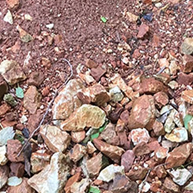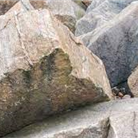
What’s the Best Way to Dig Post Holes in Rocky Ground?
If life were fair, whenever we needed to install a fence, we’d do it on level ground that was easy to dig and had great drainage.
However, life isn’t always fair, and very often, that’s not the case. If you’re wondering what’s the best way to dig post holes in rocky ground, you’ve come to the right place. Here’s what you need to know.
First, Define Rocky
The first thing you need to understand about finding the best way to dig post holes in rocky ground is that rocky ground is not all created equal.
Some, that is a mixture of clay and gravel, for instance, is very hard but can still be excavated. On the other hand, if you have large boulders to contend with, digging might not be the best solution. So when you’re trying to work out the best way to dig post holes in rocky ground, the first thing you should be doing is digging a few test holes so you can see what you’re actually dealing with.
Type 1: Gravel and Clay
 When you have gravel and clay soil mixed together, it can become a very hard substance, particularly mid-summer, when the sun bakes all the moisture out of your ground and turns it into something like a clay brick.
When you have gravel and clay soil mixed together, it can become a very hard substance, particularly mid-summer, when the sun bakes all the moisture out of your ground and turns it into something like a clay brick.
However, while this type of soil is far from easy to dig, it can still be done.
In this case, we recommend a large, hydraulic-operated jackhammer or breaker that you can use to break up the clay and gravel. These are usually available to rent, and you should look for the tow behind type that comes with a very powerful compressor.
Type 2: Small Rocks Mixed with Dirt
 The next type of rocky soil you might need to figure out the best way to dig post holes in rocky soil for is small rocks that are mixed with dirt. There might be a lot of these rocks, but they’re usually not much bigger than your fist.
The next type of rocky soil you might need to figure out the best way to dig post holes in rocky soil for is small rocks that are mixed with dirt. There might be a lot of these rocks, but they’re usually not much bigger than your fist.
This type of dirt can be excavated with something like a skid steer mounted augur, but it will take longer and be a lot harder on the augur teeth.
You can also use alternative methods like hydrovac on this type of soil, although you might still have to scoop rocks out of the bottom of your holes when they’re done.
Type 3: Solid Bedrock
 The third type of soil condition you might be dealing with when you are wondering what the best way to dig post holes in rocky soil is, is bedrock.
The third type of soil condition you might be dealing with when you are wondering what the best way to dig post holes in rocky soil is, is bedrock.
Unlike the types of soil we’ve discussed before, this is a solid sheet of very hard rock that you can’t break or dig around.
In this case, instead of digging holes for your posts, the best solution is usually to hire a coring company to core drill holes that are slightly larger than your posts and then simply grout them into place.
Since the rock is completely solid, once they are in place, your fence posts won’t be going anywhere with this method.
Type 4: Above Ground Boulders
 If you have visible rocks and boulders above the ground where you want to install your fence, you have two options: move them or work around them.
If you have visible rocks and boulders above the ground where you want to install your fence, you have two options: move them or work around them.
If you can dig between the boulders and the ground beneath is soft enough, you might be able to install your fence posts without too much trouble.
However, if there are large boulders and no way to dig between them, you might need to employ other tactics, like base plating your posts to the top or side of the boulders themselves or boxing in the spaces between them and casing your concrete into the formwork you’ve created.
What Does Hard Ground Do to the Cost of a Fence?
When most fence estimators calculate the cost of a fence, unless they have geotechnical investigation data that tells them that hard ground conditions and difficult digging will be required, they assume that they will be able to dig all of your fence post holes in the time it normally takes, with the equipment they usually use.
If they start digging and discover that’s not the case, they will probably have to recalculate your fence quote, and it could go up significantly.
There are several reasons for this.
First, there’s time. Fence labor is always calculated based on the time it will take to get the job done.
So, let’s assume that it would take them 10 minutes to dig an ordinary hole in ordinary soil. However, the same hole in hard-to-dig soil would require 30 minutes. This means that they will need three times the amount of labor to excavate the holes for your fence posts. If you have a long fence line, it’s easy to see how those costs could escalate quickly.
The second important factor is equipment requirements.
Most fence companies use one or two methods for digging holes, whether that’s hand digging with post-hole diggers or using an augur to drill holes. They probably already own the equipment they need to get the job done, and they’re skilled at using it.
However, when they need to tackle harder, more complex excavations, they probably need tools and equipment they don’t have and aren’t familiar with. This means they not only need to charge you for the equipment hired to dig the holes but also extra time because they’re not as quick and efficient using it.
Poor ground conditions and hard-to-dig post holes are probably the most common reasons that fence project costs go up, but it’s really an unavoidable and largely unpredictable problem.
What Can You Do to Mitigate the Risk of Difficult Digging on a Fence Project?
Since none of us can see what’s under the ground, it can be difficult to predict if there will be any problems once the digging on your fence project starts.
If you suspect there might be adverse subterranean conditions on your site, you might want to consider a geotechnical investigation before you start getting fence quotes, so contractors know what to expect and can build excavation costs into their quotes.
If you choose not to, it’s a good idea to add a little extra money to your project contingency fund so that if you do run into trouble, you’ve got a buffer to cover the extra cost of digging holes in less-than-perfect soil conditions.
We hope this article has helped to explain not only how to dig fence post holes in hard ground but also why it’s something you should consider on every fence project.


